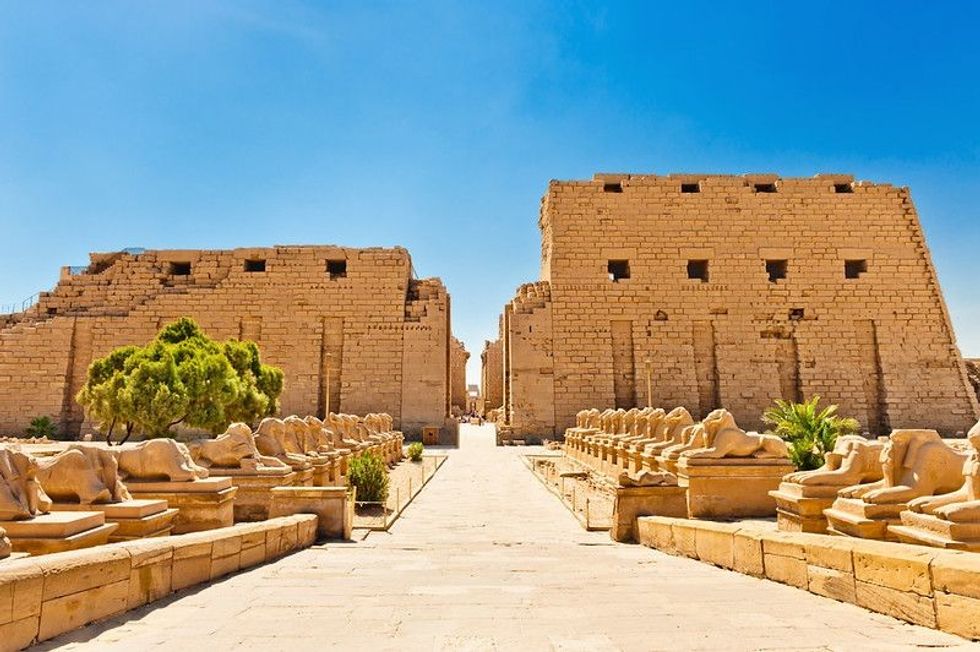The word 'Karnak' is originated in Arabic and is named for the Karnak Temple complex.
It is situated in Luxor, Egypt, which encompasses smaller temples, decayed temples, towers, and chapels built by the people of the Ptolemaic dynasty. The Nile River is situated to the east of this temple site.
It has a sacred lake at the temple sanctuary, created by Tuthmosis III. UNESCO discovered this site in 1979. This temple was constructed for the Earth goddess. This became famous after the 11th dynasty as the previous temple was a small one, and later it was built completely.
History & Origin Of Karnak Temple
The history of the Karnak Temple dates back to 2055 BC to around 100 AD, which is the largest building constructed in Egypt for religious purposes. The history is interesting regarding the oldest Egyptian rulers and their beliefs. The Roman Empire was seen in 30 BC.
This temple was built during Ramesses III, who ruled as a King from 1186-1155 BC.
The Egyptians worshiped Amun, Mut, Montu, Khonsu, and the Karnak Temple was built for these gods.
The Karnak Temple was closed during the reign of Roman emperor Constantius II as he ordered to close all of the pagan temples in Egypt.
Sensurat I was the most important King of Egyptian rulers during the 18th dynasty, his rule 'Karnak' was translated as 'The Most Selected of Places' by the Theban triad who worshipped god Amun.
The goddess Mut is the wife of Amun. Amenhotep IV established this early temple complex was led by monotheistic religion.
During the Roman Empire, few buildings were turned into Christian churches in the 4th century.
Significance Of The Karnak Temple
The Karnak Temple is famous as it is a cult temple spread wide across many temple complexes, and it has been used for religious purposes over centuries. Every Pharoah who ruled this place left their mark by establishing something at the Karnak Temple.
Tuthmose III, Seti I, Hatshepsut, and Ramesses III were important contributors to the Karnak Temple construction.
The Great Hypostyle Hall, about 54,000 sq ft (5,016 sq m), has 134 columns, also known as Karnak pillars.
Hypostyle Hall was used as a festival hall by Tuthmosis III during his reign, which is the largest room in any religious building in the world.
The Karnak complex covers about 10,763,910 sq ft (10,000,000 sq m) larger than a few ancient cities.
Visiting The Karnak Temple
Other than the Great Pyramid of Giza, the next best thing to visit in Egypt is the Karnak Temple during an Egypt tour.
The Karnak Temple can be the second-best tourist attraction as it goes back to 2055 BC.
The Karnak complex has the precinct of Amun, which is a part of the monumental city of Thebes, the precinct of Montu, the precinct of Mut, the Great Hypostyle Hall, and the sacred lake.
Karnak's pylons are also present, which serve as gateways.
The Nile River covers upper Egypt, the longest river in the world.
The precinct of Amun is only open to the public, whereas people are not allowed to visit the other archaeological sites as they are important and under research.
Architecture & Interiors Of The Karnak Temple
The Architecture of the Karnak Temple is amusing as every ruler who ruled Egypt contributed to making changes or establishing new architecture at the Karnak Temple.
There are colossal statues of Ramesses II, and the temple of sacred boats on the south in the courtyard belonged to Ramesses III.
The 134 columns consist of 12 columns that are 70 ft (21 m), and the other 122 are just 40 ft (12 m) tall.
The Egyptians preferred flat roofs, and their roof size was limited as it was supported by walls and columns.
80,000 enslaved people built over 5,000 statues to depict the power of Amun-re at Karnak.
FAQs
What was Karnak used for?
Karnak was a place of worship, and it was also used as an ancient observatory. People believed that the god Amun interacted directly with the people on Earth at Karnak.
Why is the temple at Karnak so famous?
Karnak Temple complex is famous as it is the largest religious building built on 247.11 ac (100 ha).
Who built the temple at Karnak?
During 1186-1155 B.C. Ramesses III was the King, and he built the Karnak Temple.
How many columns are there in Karnak Temple?
There are over 134 columns, also known as Karnak pillars, in Karnak Temple, out of which 12 columns support the central part and are 70 ft (21 m) tall, and the other 122 columns are about 40 ft (12 m) tall.
Who is the Temple of Karnak devoted to?
Karnak Temple is dedicated to three main gods at first, Mut and Montu, Amun, and Khonsu.
Did Karnak Temple have a roof?
Yes, the Karnak Temple did have a flat roof, but it was limited as it was supported by the walls and columns, which altered its size.








